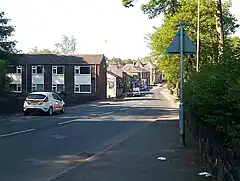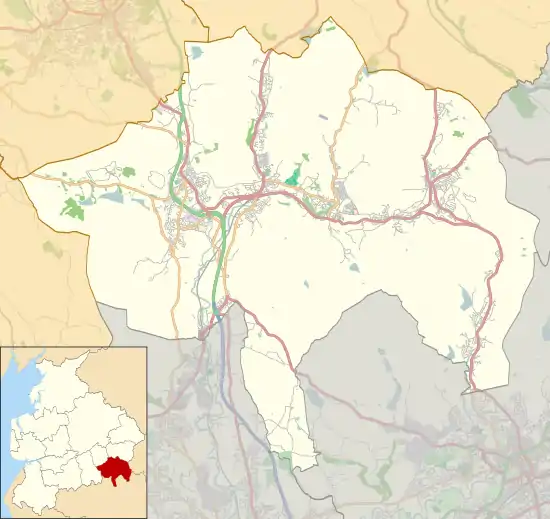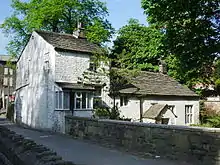Crawshawbooth
Crawshawbooth is a small village located on the edge of the Pennines in England, just north of the market town of Rawtenstall, Lancashire, and south of Loveclough. It is situated in the Rossendale Valley, which was once an ancient royal hunting ground. The majority of the surrounding land consists of farms and moorland, attracting many walkers to the area.
| Crawshawbooth | |
|---|---|
 Entering Crawshawbooth from Rawtenstall | |
 Crawshawbooth Location within Rossendale  Crawshawbooth Location within Lancashire | |
| OS grid reference | SD810254 |
| District | |
| Shire county | |
| Region | |
| Country | England |
| Sovereign state | United Kingdom |
| Post town | Rossendale |
| Postcode district | BB4 |
| Dialling code | 01706 |
| Police | Lancashire |
| Fire | Lancashire |
| Ambulance | North West |
| UK Parliament | |
Etymology
The name "Crawshawbooth" is derived from two elements: "Crawshaw" and "booth."
The first element, "Crawshaw," refers to a family name associated with the village. It is believed that the name originates from the Old English words "crawe" meaning "crow" and "sceaga" meaning "grove" or "woodland." Over time, the name evolved and eventually became associated with the area.
The second element, "booth," refers to a small dwelling or temporary shelter historically used by farmers or traders. This term reflects the village's historical connection to the agricultural and trading activities that took place in the region.
The combination of "Crawshaw" and "booth" signifies the historical presence of a dwelling or settlement belonging to the Crawshaw family. This connection to both a family name and a type of dwelling highlights the village's history and heritage.
Crawshawbooth has preserved its name over the years, serving as a reminder of the area's past and the families that once inhabited and influenced the development of the village.
Geography
Crawshawbooth is nestled within the Rossendale Valley, an area renowned for its scenic beauty and rich history. The village is surrounded by verdant farmland and vast stretches of moorland, creating a serene and idyllic environment.
The topography of Crawshawbooth is characterized by rolling hills, giving rise to stunning panoramic views of the surrounding countryside. The area is crisscrossed by various footpaths and trails, making it a haven for walkers and outdoor enthusiasts. Visitors can explore the nearby countryside with ease. The village is also intersected by several small rivers and watercourses, including Limy Water and the Folly Clough.
Historical aspects
There are a number of English Heritage properties here.
Crawshaw Hall is a Grade II* listed mansion built in 1831 by John Brooks, a well-known local calico printer and quarry owner. His son Sir Thomas Brooks was created a baronet in 1891 and the following year raised to the peerage as Baron Crawshaw. Sir Thomas was appointed High Sheriff of Lancashire for 1884–85. The property descended in the Brooks family until it was sold in 1976. It has been a medical centre and nursing home since 1987.[1]
The Religious Society of Friends (Quakers) Meeting House in the village is one of the oldest in the world (it was built in 1716). The village has many historical aspects such as Victorian-style housing and huge chimneys from the early Victorian Era. There was also a large cotton and shoe making industry in the Victorian Era.
Goodshaw Chapel was associated with the Larks of Dean.
St. Mary and All Saints Church, commonly known as "Goodshaw Chapel," has a rich history dating back to 1542. Over the years, it underwent several renovations, with notable work carried out in 1780 and 1828. This stone church features a rectangular structure with a small western turret housing a single bell. It offers seating for 912 individuals, including 357 free seats. The church's historical records include baptisms dating from 1732, marriages from 1838, and burials from 1755. [2]
St. John the Evangelist Church was constructed in 1892 at a cost of £12,000. Originally a chapel of ease for St. Mary's, it has a seating capacity for 600 worshippers. The church was designed by renowned architects Paley and Austin. It currently is in disrepair and abandoned for the foreseeable future.
Life and tourism

The village is home to Crawshawbooth Primary School, which is situated outside of the main village. In terms of amenities, there are several shops and eating places available to residents and visitors. These include a fish and chip shop, an Indian restaurant, a Chinese takeaway, and an Italian restaurant. Additionally, there is a newsagents, a dry cleaner, and a public library.[3] The village is also known for its award-winning butchers.[4]
In terms of pubs, the village is home to establishments such as the Black Dog and Masons Arms, as well as the White Bull Pub. A newly established bar called Lizzies Bar has also become a part of the village's scene. These venues offer a place for residents and visitors to socialize and enjoy a drink.
The main road in the village is lined with a number of Victorian houses. Nearby, you will find the towns of Rawtenstall and Burnley, as well as the hamlet of Loveclough.
Crawshawbooth was also home to the See Gallery who mounted regular exhibitions of local nationally and internationally known artists including, amongst others, Ray Lowry, Liam Spencer, Dave Pearson and John Hyatt.
Notable residents
- Raleigh Croshaw (ca.1584–1624) an English merchant and immigrant to the Colony and Dominion of Virginia
- Thomas Brooks, 1st Baron Crawshaw (1825–1908) a British peer.
- Marshall Brooks (1855-1944) sportsman, high jump champion, rugby union international and JP
- Jimmy Dickinson (1899–1971) footballer with almost 200 club caps
- Ted Robbins (born 1955) a comic, actor, TV presenter and radio broadcaster
- Phil Neville (born 1977) footballer, played for Manchester United F.C., Everton F.C. and England
See also
References
- "Crawshaw Hall History". Retrieved 8 November 2013.
- "Kelly's Directory of Lancashire".
- "Crawshawbooth Public Library". Archived from the original on 8 January 2015. Retrieved 23 January 2016.
- "Rossendale butchers sweep the board at meat 'Oscars'". Lancashire Telegraph. Retrieved 3 July 2015.